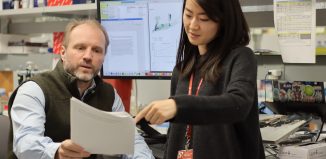Studying the cold facts of superconductors
Some objects are like closed boxes. They have some observable properties but scientists don’t know exactly what is happening inside or why.
That’s where experimental physicists like Mark Dean and his colleagues at Brookhaven National Laboratory enter the picture. Dean fires X-rays with a specific energy level at copper oxide-containing materials (compounds that have copper and oxygen). To determine what’s going on inside, he sees how the X-rays change in energy and direction.
“We try to understand materials at a fairly fundamental level,” Dean said. “We think of that as a recipe that can be used for future technology.”
Copper oxide materials have magnetic properties and act as superconductors. Typical conductors have resistance, which reduces the amount of electricity received.
Superconductors, however, don’t have any resistance, which makes them potentially more efficient materials to send electricity. The catch, however, is that most superconductors require temperatures at near absolute zero — the universe’s coldest possible temperature — which makes them less practical. The energy required to cool the superconductors can be higher than the cost savings from avoiding the resistance of typical conductors.
Dean is focused on understanding the relationship between magnetism and superconductivity in these copper oxide substances.
The X-rays he fires into a material kick an electron out of the core of an atom, sending it up into a higher energy state where that electron can interact magnetically. That makes the X-rays sensitive to the magnetic properties of the material, he explained.
When a new electron replaces the one that was kicked out, it emits an X-ray photon. Dean measures the direction and energy loss of the photon in a process called resonant inelastic X-ray scattering.
Dean studies flat planes of compounds with copper and oxygen that are stacked on top of each other. These objects have superconducting properties at a relatively high temperature — about 90 Celsius degrees above absolute zero. That is still incredibly cold by human standards: about 300 degrees below zero on the Fahrenheit scale.
In the world of superconductors, that is considered “very warm,” or about a factor of 10 higher temperature than most normal superconductors, he said.
In terms of the energy trade-off between benefiting from the properties of a superconducting material and keeping that object cold enough to function, it is “becoming closer and closer to break-even,” Dean said. In five to 10 years, “we might hope to see some more areas where it’s economic” to use superconductors instead of conventional wiring.
Researchers discovered objects with copper and oxygen that had superconducting properties about 25 years ago and have been studying them extensively. To this point, they have “yet to find a satisfactory explanation of this phenomenon,” Dean said.
Dean is eager to refine the experiments when the National Synchrotron Light Source II comes online in 2015. At the NSLS-II, researchers will produce X-rays that are 10,000 times brighter than the current NSLS, enabling researchers to analyze the structure of new materials.
Chris Howard, a lecturer in the Department of Physics and Astronomy at University College in London, U.K., has confidence that Dean, with whom he has collaborated since 2007, will build on his success.
Dean is “currently proving his ability with a string of important and far-reaching publications in superconductivity and materials physics,” Howard offered. He called Dean a “real doer” and observed that he “is rapidly gaining the respect of the community he works in.” Howard appreciates the combination of Dean’s technical expertise, scientific discipline, writing skills, analytical skills and experimentation abilities.
Growing up in Broadstairs, Kent, a coastal town in southeast England, Dean developed an interest in science when he was young, where nature, through insects and wildlife documentaries and trips to zoos, appealed to him.
“As I grew older, the elegance of physics is what caught me,” he said. “The idea to conceptualize something and write down a formula: it’s such a beautifully efficient way of explaining something. You can convey a spectacular amount of information if you know how to write down the formula to describe it.”
A resident of Rocky Point, Dean came to the United States immediately after earning his doctorate. He enjoys mountain biking.
As for his work, Dean said the first semiconductor transistor was made at Bell Labs without any thought for its possible connection to the computer. It was made by scientists who were working to understand the properties of semiconductors. They didn’t realize this would lead to a semiconductor-based computer.
In a similar way, he said, by studying materials with novel properties, scientists will create “opportunities to make interesting new devices.”






